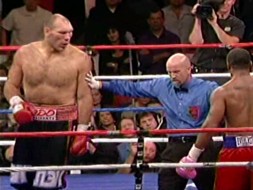 06.04.07 – Jonathon Oakley: The Beginning…The development of boxing in Tsarist and early Communist Russia. Given the current domination of the heavyweight division by fighters from nations of the former USSR – 3 of the four major world title belts in this division are held by two Russians (Valuev and Maskaev) and a Ukrainian (Klitschko) – It seems an intriguing opportunity to offer an assessment how boxing in the former Soviet Union grew, developed and evolved into a major force in the sport’s global context.
06.04.07 – Jonathon Oakley: The Beginning…The development of boxing in Tsarist and early Communist Russia. Given the current domination of the heavyweight division by fighters from nations of the former USSR – 3 of the four major world title belts in this division are held by two Russians (Valuev and Maskaev) and a Ukrainian (Klitschko) – It seems an intriguing opportunity to offer an assessment how boxing in the former Soviet Union grew, developed and evolved into a major force in the sport’s global context.
Indeed, the influx of highly rated fighters from former Soviet states to the professional heavyweight boxing ranks extends, innumerably, way beyond a handful of world champions. Further down the scale, Ukrainians Virchis and Dimitrenko and Russian Ibragimov endeavour to secure world title fights, while Uzbekistan’s Chagaev challenges Valuev for the WBA version of the title on the 17th of this month.
Venture beyond the top 20, and you find Lyakhovich, Bidenko, Platov, and Russian prospect Povetkin. The development of such wealth of talent is rivalled only by the United States, who have produced 20 of the current top 50 world heavyweights. Why, then, is this the case? In Part 1, I intend to discuss the origins of boxing as an organised sport in Russia, and the social and political influences exerted on it after the 1917 revolution.
The development of boxing, in terms of its Soviet exponents, cannot be treated in isolation but must be put into the wider context of organised sport. Russia in the 1860s was experiencing profound change in the economic and social landscape, as the abolition of serfdom led to an expansive range of opportunities in industry. Industry became geographically concentrated into nucleus cities and allowed urbanisation to become a powerful social force. Newly established clubs were permitted significantly larger potential membership as the wealth middle and upper classes participated in their class activities and wagered on others. Organised Soccer and Athletics began in earnest in the 1890s while Yachting, reserve of the beneficiaries of the class system, gained institution somewhat earlier, in the 1860s.
Boxing, in this respect, struggled to shake its prohibitively violent and non-codified image, even after the introduction to Russia in 1894 (according to Riordan) of the Marquess of Queensberry’s rules (1866) and remained restricted to limited participation and rather more extensive wagering for some time thereafter. Despite a national championship event in 1914, boxing had struggled for two decades to gain notoriety and recognition of its requisite level of technical ability.
By 1917, in the midst of war, Bolshevik revolution had overthrown the Tsarist rule and drastically altered the social conventions it left behind. As a keen sportsman himself, and armed with his interpretation of Marxist ideology, Lenin set out to impart onto the Russian conscience the important of physical alongside mental development. Marxist-Leninism dictated that physical fitness was conducive to productive labour, essential to communist survival in austerity of post-war Russia. Sport in the Soviet Union was useful for this purpose because of its accessibility, requiring no fees or political sympathies.
Boxing was particularly relevant to the Soviet conscience in the post war period as various socio-political pressures pulled it in different directions. Sport, along with soviet politics, became increasingly militarised after 1918, as a consequence of threats to the communist state. The combative nature of boxing provided an obvious appeal, yet significantly, boxing was also reviled by many of the ideological splinter groups, such as the Proletkult movement, coming from an increasingly fractionalised Bolshevik party.
Competitive sports were seen as counter-productive to Communism and symptomatic of the unhealthy capitalist greed for wealth and success at the expense of others. For groups such as the Proletkultists boxing, in its very nature as a combat sport, provided a scathing indictment of the nature of competitive sport. In any case, boxing as a tactical, physical and demanding activity survived the revolutionary period through its relevance to (in terms of its nature), and distance from, contemporary politics. Yet, as observed by Espy, sport retains a fundamental, ‘essential neutrality’ and this fluidity allowed boxing to resist the various pressures put upon it. Part 2 will look at amateurism and Soviet Olympic boxing.
(I would welcome comments from ESB readers. I am just starting out with my writing so any observations would be much appreciated. Regards, Jonny.)